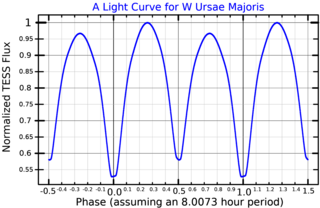
W Ursae Majoris is the variable star designation for a binary star system in the northern constellation of Ursa Major. It has an apparent visual magnitude of about 7.9, which is too faint to be seen with the naked eye. However, it can be viewed with a small telescope. Parallax measurements place it at a distance of roughly 169 light years (52 parsecs) from Earth.
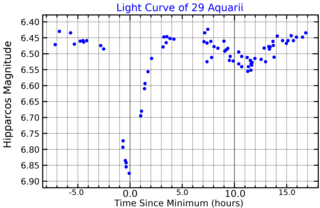
29 Aquarii is a binary star system located around 590 light years away from the Sun in the equatorial constellation of Aquarius. 29 Aquarii is the Flamsteed designation; the system also bears the variable star designation DX Aquarii. It is a challenge to view with the naked eye, appearing as a dim star with a combined apparent visual magnitude of 6.39. The system is moving further from the Earth with a heliocentric radial velocity of about +15 km/s.
3 Centauri is a triple star system in the southern constellation of Centaurus, located approximately 300 light years from the Sun. It is visible to the naked eye as a faint, blue-white hued star with a combined apparent visual magnitude of 4.32. As of 2017, the two visible components had an angular separation of 7.851″ along a position angle of 106°. The system has the Bayer designation k Centauri; 3 Centauri is the Flamsteed designation. It is a suspected eclipsing binary with a variable star designation V983 Centauri.

HW Virginis, abbreviated HW Vir, is an eclipsing binary system, approximately 563 light-years away based on the parallax measured by the Gaia spacecraft, in the constellation of Virgo. The system comprises an eclipsing B-type subdwarf star and red dwarf star. The two stars orbit each other every 0.116795 days.

WR 22, also known as V429 Carinae or HR 4188, is an eclipsing binary star system in the constellation Carina. The system contains a Wolf-Rayet (WR) star that is one of the most massive and most luminous stars known, and is also a bright X-ray source due to colliding winds with a less massive O class companion. Its eclipsing nature and apparent magnitude make it very useful for constraining the properties of luminous hydrogen-rich WR stars.

Chi2 Hydrae, Latinised from χ2 Hydrae, is a binary star system in the equatorial constellation of Hydra. Based upon an annual parallax shift of 4.6 mas as seen from Earth, it is located roughly 685 light years from the Sun. It is visible to the naked eye with a combined apparent visual magnitude of about 5.7.

16 Lacertae is a triple star system in the northern constellation of Lacerta, located about 1,580 light years from the Sun. It has the variable star designation EN Lacertae; 16 Lacertae is the Flamsteed designation. This system is visible to the naked eye as a faint blue-white hued star with a maximum apparent visual magnitude of +5.587. It is moving closer to the Earth with a heliocentric radial velocity of –12 km/s.

FL Lyrae is the variable star designation for an eclipsing binary star system in the northern constellation of Lyra. The combined apparent magnitude of the pair is 9.36, which means they are too faint to be seen with the naked eye. Parallax measurements put the system at a distance of around 437 light years from the Sun. This star system was in the view field of the Kepler space telescope during 2009−2014, which allowed monitoring during that spacecraft's mission.
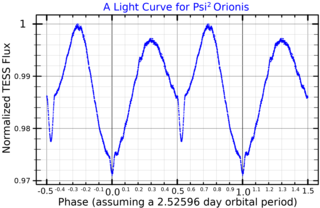
Psi2 Orionis a binary star system in the equatorial constellation of Orion. It has an apparent visual magnitude of 4.6, indicating that it is visible to the naked eye. Based upon an annual parallax shift of 2.87 mass, it is roughly 1,100 light years distant from the Sun.

HO Telescopii is an eclipsing binary star system located in the southern constellation of Telescopium. The maximum apparent visual magnitude of 8.22 is too faint to be visible to the naked eye. The system is located at a distance of approximately 910 light years based on parallax. The combined stellar classification of the system is A7III(m), matching an evolved A-type star that is possibly metallic-lined. The system is around 1.1 billion years old and consists of two stars of similar mass and size.
Phi Phoenicis, Latinized from φ Phoenicis, is a binary star system in the southern constellation of Phoenix. It is faintly visible to the naked eye with an apparent visual magnitude of 5.1. Based upon an annual parallax shift of 10.185 mas as seen from Earth, it is located approximately 320 light years from the Sun. It is moving away with a heliocentric radial velocity of 10.4 km/s.

Xi Phoenicis, Latinized from ξ Phoenicis, is a visual binary star system in the southern constellation of Phoenix. It is faintly visible to the naked eye, having an apparent visual magnitude of 5.70. Based upon an annual parallax shift of 14.61 mas as measured from Earth, it is located around 223 light years from the Sun. The system is moving away from the Sun with a radial velocity of about +10 km/s.
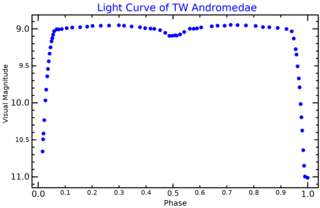
TW Andromedae is an eclipsing binary star, classified also as an Algol variable star, in the constellation Andromeda. Its brightness varies with a period of 4.12 days, and has a typical brightness of magnitude 8.98 but decreasing down to a magnitude of 11.04 during the main eclipse.
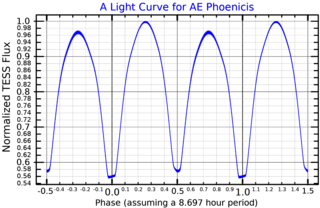
AE Phoenicis is a variable star in the constellation of Phoenix. An eclipsing binary, its apparent magnitude has a maximum of 7.56, dimming to 8.25 during primary eclipse and 8.19 during secondary eclipse. From parallax measurements by the Gaia spacecraft, the system is located at a distance of 168 light-years from Earth.
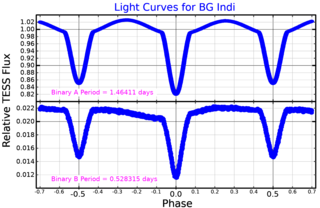
BG Indi, also known as κ1 Indi is a multiple star system in the southern constellation of Indus. Its average apparent magnitude is 6.141, meaning it can only be seen by the naked eye under exceptionally good viewing conditions. Stellar parallax measurements by Gaia put the system at about 166 light-years away.

HS Hydrae is a triple star system in the equatorial constellation of Hydra. The inner pair were an eclipsing binary during the period 1920 until 2019, with HS Hya being the variable star designation. With a base apparent visual magnitude of 8.08, HS Hya is too dim to be viewed with the naked eye. During the primary eclipse, the magnitude dropped to 8.61; the secondary eclipse lowered the magnitude to 8.55. Based on parallax measurements, the system is located at a distance of approximately 335 light years from the Sun. It is drifting closer with a mean radial velocity of −7 km/s.

14 Trianguli, also known as HD 15656, is a spectroscopic binary located in the northern constellation Triangulum. It has an apparent magnitude of 5.14, making it faintly visible to the naked eye in ideal conditions. Gaia DR3 parallax measurements place the system 433 light years away, and it is currently approaching the Solar System with a heliocentric radial velocity of −37 km/s. At its current distance, 14 Tri's brightness is diminished by 0.21 magnitude due to interstellar dust. It has an absolute magnitude of −0.46.

HU Tauri is a tight binary star system in the equatorial constellation of Taurus. It is an eclipsing binary, which means that the member stars periodically eclipse each other every 2.056 days. They have a combined apparent visual magnitude of 5.85, which is bright enough to be dimly visible to the naked eye. During the primary eclipse, the magnitude drops to 6.68, while the secondary eclipse decreases the magnitude to 5.91. The distance to this system, based on parallax measurements, is approximately 414 light years.

RS Sagittarii is an eclipsing binary star system in the southern constellation of Sagittarius, abbreviated RS Sgr. It is a double-lined spectroscopic binary with an orbital period of 2.416 days, indicating that the components are too close to each other to be individually resolved. The system has a combined apparent visual magnitude of 6.01, which is bright enough to be faintly visible to the naked eye. During the primary eclipse the brightness drops to magnitude 6.97, while the secondary eclipse is of magnitude 6.28. The distance to this system is approximately 1,420 light years based on parallax measurements.

HD 93486, also known as HIP 52381, is a binary star located in the southern circumpolar constellation Chamaeleon near the border with Octans. Its variable star designation is RZ Chamaeleontis. It has an apparent magnitude ranging from 8.2 to 9.1, which is below the limit for naked eye visibility. Gaia DR3 parallax measurements place the system 568 light years away, and it is currently receding with a heliocentric radial velocity of 20 km/s. At its current distance, HD 93486's average brightness is diminished by 0.53 magnitudes due to interstellar dust. The system has a combined absolute magnitude of +1.72.


















